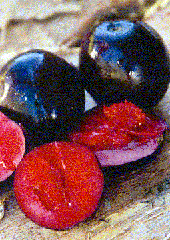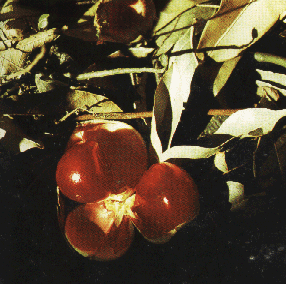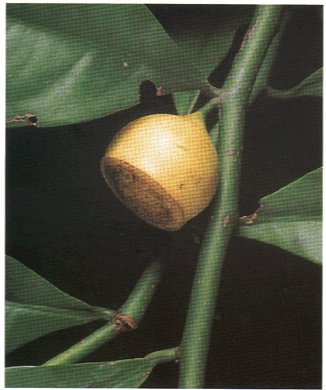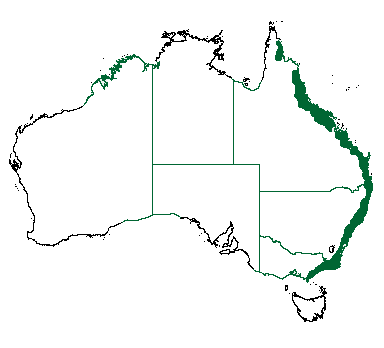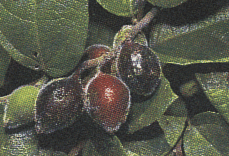Fruits - 'D-F' |
|
Diploglottis spp | Enchylaena tomentosa | Eugenia reinwardtiana | Eupomatia laurina | Ficus spp |
|
|
|
|
Davidsonia spp |
|
Davidson plum |
|
|
Family |
Cunoniaceae |
General notes:Botanically, Davidsonia spp. are not related to the true European plums but the fruit has some similarities in size, form, colour and flavour. There are two popular species, native to rainforests of subtropical and tropical Eastern Australia, Davidsonia pruriens and D. jerseyana. The smaller northern NSW D. jerseyana, is probably the most frequently planted in commercial orchards. The fruit is more flavourful but is smaller than D. pruriens. D. pruriens has larger fruit than D. jerseyana. Perhaps not as 'flavourful' as D. jerseyana, it makes excellent jams, jellies, sauces, etc. Both have a sharp, rather refreshing taste. Edible portion:Fruit Harvest period:March - July. Also given by Les Hiddens as Aug - Jan. In Lismore (N. NSW): Dec-Jan. In N. Qld: Feb-May. Atherton (N. Qld): Apr-Sept. Yrs to maturity:3-5 Form:Small to medium tree, growing 6-8 m Natural Distribution/Growing conditions:D. pruriens occurs naturally in lowland and upland rainforest in NE Queensland. D. jerseyana occurs naturally only in the Tweed and Brunswick valleys, on the far north coast of NSW. It usually grows as an understorey in lowland subtropical rainforest and wet schlerophyll forests, in soils of basaltic and sedimentary origin. Climatic/microclimatic conditions:Production is ideally suited to regions with a rainfall exceeding 800 mm per annum, preferably distributed through-out the year. They prefer shelter from dry, hot and cold winds - require adequate windbreaks and shelter as young trees. D. jerseyana can survive temperatures down to -5oC. but extended periods below -3oC can cause leaf burn in young trees. Young trees tolerate no frost. Small Acacia spp. have been used to provide protection to young trees in frosty sites. Management reference:Davidsonia spp are adaptable to a range of soil types, but prefer a friable soil high in organic matter. Regular applications of rich compost are suggested. Pre-planting soil treatments include: gypsum. ag-lime, rock phosphate and rock dusts, usually accompanied by deep ripping and legume cover cropping. Comparisons between existing plantings and various fertilising schedules is required to identify the preferred soil nutrition program. Good soil moisture levels are required to establish orchards, also in mature trees to initiate flowering and during fruit set and fruiting. Adequate soil moisture levels appear to be a major trigger for flowering - reasonably sized fruit and high juice content indicate that water requirements may be substantial. It is claimed that hand nipping D. jerseyana and D. pruriens will give greater yields. The greatest problems for young plants are: wind-burn, sun-burn and moisture stress. Trees are usually planted close, from 1 to 2.5 m within rows, often with taller growing trees being included. Between row spacing usually varies from 2.2 to 5 m, suitable for small farm machinery access, and usually in block plantings. D. pruriens can be used as a shelter tree for the more sun sensitive D. jerseyana. Although D. jerseyiana can be subject to a number of pests these are thought not to be beyond the capacity of "organic" standard control methods. There is disagreement on this. Good control of the fruit fly Dacus spp has been achieved with harvesting the green unripe fruit and allowing drying to occur off the tree. As a young seedling D. pruriens is more tolerant of full sun conditions than D. jerseyana. Because of its autumn/winter fruiting period D. pruriens has a lower rate of fruit pests than D. jerseyana Traditional Aboriginal Use FruitFruit eaten Density:275/haYield at maturity:Yields are reasonably consistent between D. jerseyana seedling trees but vary yearly. A six year old tree growing in reasonable conditions and with a single trunk had 300 fruit weighing 4 kg. Ideal conditions, in a no wind risk situation, would include multi-trunk, single row system with canopy tree protection and netting harvest method. Greatest yield would be achieved through inter-row spacing of 3.5 m and a planting density of approx. 1,350 trees per ha (5,400 trunks at av. of 4 trunks per tree). Fruit yields between D. pruriens is highly variable varying from approx 40 kg at year 9 (70kg at year 12 also claimed) while other seedling trees hardly bear at all. Therefore cash flow projections need to be based on an average of these. Harvesting:By hand. It is necessary to avoid contact with irritant hairs (when trunk shaking to drop fruit) by wearing gloves, long sleeved shirts and broad rimmed hats. Irritant hairs found on fruit and leaves of D. pruriens and leaves only of D. jerseyana. Fruit ripens over a 2 to 4 week period and should be harvested during the cooler parts of the day, preferably early in the morning, every two or three days. It is easier to pick the green fruit. A fruit bin and shelf storage system in cold rooms would be most suitable for bulk quantities. Supplied as:Fresh, frozen. Typical value adding:Best known for the tangy deep crimson jam they are also used in sauces (savoury & sweet), wine, salad dressing, desserts, fruit leather, preserves, conserves, confectionery, juices and cordials. Fruit pulp could be frozen or processed on-farm. Fruit is used to produce jam, make wine, stewed with sugar, and colouring and flavouring in sauces, ice-creams and drinks. Current purchasing price:$11-$15/kg: washed and split. $6-$15/kg whole/frozen, depending on season and demand. Perceived demand:Reasonably high LinksSee also the Witjuti Grub Nursery article on the Davidson plum here. Teachers net: http://www.teachers.ash.org.au/bushtucker/davidsons_plum.htmlCSIRO: http://www.cse.csiro.au/research/nativefoods/crops/plumsdav.htmDaleys: http://www.daleysfruit.com.au/bushfood/davidsons.htmThreatened species: http://threatenedspecies.environment.nsw.gov.au/tsprofile/profile.aspx?id=10208http://www.valleyofthemist.com.au/bush-food-products.htmSee also - Davidson plum |
|
Diploglottis sppMost especially: D. australis, D. campbellii and D. dyphlostegia |
D. cunninghamia |
Native tamarind, Small leaf tamarind |
|
|
Family |
Sapindaceae |
General notes:From the same family as such exotic fruits as rambutan and lychee, the fruit of D. campbellii has a very pleasant tart-apricot taste. The seeds are large. D. cunninghammii is also edible but it is on the rare and endangered list and thus supply of stock could be vexatious. Edible portion:Fruit Harvest period:Summer Yrs to maturity:3-5 to first bearing, longer for maturity Form:Tree to 25m (in canopy situation). More likely 8-10 in the open. Natural Distribution/Growing conditions:N. NSW and SE Qld in riverine forests although it is stated that it grows well in Sydney. Climatic/microclimatic conditions:Sub tropical but will also grow well in sub-tropical to temperate regions given some protection. Management reference:There is contradictory information here - one grower maintaining the young D. campbellii requires shelter from full sun and wind and another maintaining his had flourished on an exposed, windy hill. In my own planting two needed shelter from full sun and one flourished in an exposed position! Traditional Aboriginal use:Fruits were eaten Density:3m in row, 5m between rows Yield at maturity:Unknown Harvesting:Hand Supplied as:Fresh Typical value adding:As per tamarinds. Great addition to jams, jellies and ice cream or yoghurt. Current purchasing price:NCT. Estimated $6/kg Perceived demand:Growing Research also:D. diphyllostegia - Northern tamarind (tropical) Links
|
|
Enchylaena tormentosa |
|
Ruby saltbush |
|
|
Family |
Chenopodiaceae |
General notes:The fruits of this widespread bush are small and shiny red, there is little flesh and a large seed - however, it has been included in this kit because of its interesting salty-sweet taste and its great numbers. Edible portion:Fruit Harvest period:Berries ripen almost any time of the year Yrs to maturity:1-2 Form:Dwarf shrub Natural Distribution/Growing conditions:Arid regions, sandy soils. A more prostrate form is also found in coastal regions. Good for saline soils. It is often found near salt pans inland. Being very widespread, it seems tolerate a wide range of conditions: Climatic/microclimatic conditions:Arid - subtropical - temperate - coastal. Management reference:NIL Traditional Aboriginal Use:Fruit:were eaten Density:Unknown Yield at maturity:Unknown Harvesting:Hand Supplied as:Hardly supplied at all. The keeping qualities not known, most likely supplied fresh. Typical value adding:The unusual salty sweetness of the berry could be a selling point. The settlers soaked the berries and drank the resulting juice. Removing the small amount of flesh could be a challenge. I don't believe anyone has value added to date! Berries can also be used to make dye. Current purchasing price:$NMV at present Perceived demand:Low but could grow with promotion or some creativity. LinksASGAP: http://asgap.org.au/e-tom.htmlDPI VIC http://www.dse.vic.gov.au/dpi/vro/vrosite.nsf/pages/water_sss_ruby_salt_bush |
|
Eugenia reinwardtiana |
 |
Beach cherry, Cedar Bay Cherry |
|
|
Family |
Myrtaceae |
General notes:This is one of the few sweet 'punnet' fruits, much loved by those who have tried it. Edible portion:Fruit - about 2cm Harvest period:Jun- Feb or Dec-Jun Yrs to maturity:First fruit 3-4, maturity 6-10 yrs Form:Attractive shrub, approx 2mx2m Natural Distribution/Growing conditions:Widely distributed, found on or near beaches. Also found in monsoon forests and deciduous vine thickets. Climatic/microclimatic conditions:Tropical to sub-tropical Management reference:Slow growing, subject to scaleTraditional Aboriginal UseFruits were eaten Density:3mx4m best Yield at maturity:Unknown Harvesting:Hand Supplied as:Fresh, frozen Typical value adding:Usually eaten fresh but could possibly be used as one would cherries (ie frozen and used in pies, sauces, etc). Current purchasing price:$NCT - estimated $6-10/kg fresh fruit market Perceived demand:Unknown LinksASGAP http://www.sgapqld.org.au/bushtucker9.htmlAlstonville Tree Farm http://www.treefarm.com.au/Eugenia_reinwardtiana_x.htmDaleys http://www.daleysfruit.com.au/plant/Beach-Cherry-Eugenia-Reinwardtiana.htm
|
|
Eupomatia laurina |
|
Bolwarra, Native Guava |
|
|
Family |
Eupomatiaceae |
General notes:Fine garden or indoor specimen. Resembling a lemon tree, it has glossy green leaves with red new growth. It is considered to be a species of very ancient origin with very few close relations in our modern floras. The fruits are 2cm (larger in north Qld) and resemble rose hips, with many bitter tasting seeds When soft they are aromatic and resemble a guava in flavour. Edible portion:Fruit Harvest period:April to June. Nov-Feb. Yrs to maturity:Unknown Form:Small tree to 6m Natural Distribution/Growing conditions:Victoria, New South Wales, Queensland, (in or near rainforest) Climatic/microclimatic conditions:May be frost sensitive, does very well in deep shade. Management reference:As for exotic guava (Psidium spp)? Should be pruned from an early age to encourage stronger branches. It prefers shade, ample moisture and a well composted soil. Traditional Aboriginal UseFruits eaten Density:625/ha Yield at maturity:Unknown Harvesting:Hand Supplied as:Fresh Typical value adding:Unknown Current purchasing price:NCT Perceived demand:Unknown LjnksSGAP http://www.sgapqld.org.au/bushtucker16.html |
|
Ficus spp |
|
Sandpaper fig, Native fig |
Ficus coronata |
|
Family |
Moraceae |
General notes:The editor's own F. coronata is dry and rather unpalatable but there is great variability - a F. coronata growing not 10 km away had sweet, very palatable fruit. According to Hiddens, the fruit of F. racemosa is quite excellent. F. superba is also said to be very sweet. Edible portion:Fruit Harvest period:F. coronata - varies (according to Hiddens) but mine seems to fruit particularly from Dec-Mar. F. racemosa - two fruiting seasons - Feb/Mar/Apr and Jul-Nov Yrs to maturity:2-3 Form:F. coronata - sprawling small tree to 10m . F. racemosa - more thick-set tree to 30m Natural Distribution/Growing conditions:F. coronata - in open areas and verges of rainforest. Most particularly found near watercourses. F. racemosa - rainforest and close woodland Climatic/microclimatic conditions:F. coronata - wet and dry tropical and sub-tropical regions F. racemosa - tropical and sub-tropical regions of the north. Management reference:As for fig. F. coronata's viney, spreading habit makes hand harvesting reasonably easy. F. racemosa's height (up to 30m) could present problems. Top pruning could be attempted. Traditional Aboriginal Use:Fruits were eaten Density:Fig. F. coronata is probably not suited to plantation growing but could do well along fencelines, water courses, difficult areas and as an edge planting. F. racemosa could be treated as a large tree (ie 300-400/ha). Yield at maturity:Unknown. Fertilising increases the yield of F. coronata Harvesting:Hand Supplied as:Fresh or dried Typical value adding:F. coronata - dried, candied. You can use the leaves as a fine sandpaper! F. racemosa - dried, candied Current purchasing price:$NMV Perceived demand:Low at present Research also:Ficus platypoda (Wild fig - arid regions) Ficus superba (sandfig)
|
|
|
|
|

